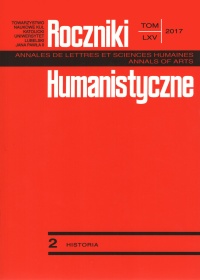The image of the parish clergy based on Wincenty De Seve’s inspection (1608-1609) – selected aspects
Abstract
The article discusses an important period in the Church history – the so-called Church reform. It occurred after King Zygmunt August (1564) and the Polish clergy (1577) had adopted the resolutions of the Council of Trent. The implementation of those resolutions commenced at the turn of the 16th and 17th centuries. One of the postulates was the renewal of the life of the clergy – attitude to obligations and improvement of morals, customs and even external appearance. Wincenty de Seve’s inspection in the years 1608-1609 concerned the area of the archdeaconry of Gniezno. For the purposes of this article, its four deaneries were analysed: Holy Trinity, Saints Peter and Paul, Łekno and Sompolno.
The main purpose of the inspection was the parish, which played an extremely important role in the society. The article discusses the image of the parish clergy resulting from the conducted inspection, whereby the inspection took into account the reform guidelines. From this image it follows that both people who were models and those who drastically violated different norms were rather exceptions. The most numerous group formed clergymen who mostly met the requirements, however, still various irregularities could be noticed. The biggest problems of the next, slightly smaller group were women and alcohol. The offenses also included lack of knowledge, sloppiness and inappropriate attire.
The inspection shows that at the beginning of the 17th century, attempts were made to implement the reform of the parish clergy, but the elements of old habits and new norms could be found concurrently.
References
Aleksandrowicz M., Archidiakonat gnieźnieński w latach 1706-1721, Lublin 1973, praca doktorska, mps autora.
Aleksandrowicz M., Początkowe dzieje seminarium duchownego w Gnieźnie (1602-1718), „Nasza Przeszłość” 24 (1966), s.167-183.
Aleksandrowicz M., Wychowawcy i wychowankowie seminarium gnieźnieńskiego w latach 1602-1718, „Roczniki Teologiczno-Kanoniczne” 12 (1965), z. 4, s. 111-131.
Bruździński A., Działalność prymasa Stanisława Karnkowskiego w zakresie wprowadzania uchwał Soboru Trydenckiego w Polsce 1581-1603, Kraków 1996.
Glemma T., Banaszak M., Kumor B., Przyjęcie reformy trydenckiej w Kościele polskim, w: Historia Kościoła, t. I, cz. 2, red. B. Kumor, Z. Obertyński, K. Dola [i in.], Poznań 1974, s. 173-207.
Historia Kościoła w Polsce, t. I: Do roku 1764, cz.1: Do roku 1504, red. B. Kumor, Z. Obertyński, K. Dola [i in.], Poznań–Warszawa: Pallottinum 1974.
Jabłońska A., Funkcje społeczne parafii archidiakonatu gnieźnieńskiego w XVII wieku, Kielce: UJK 2013.
Jabłońska A., XVII-wieczny szpital św. Marty w Gnieźnie w świetle księgi rachunkowej, „Nasza Przeszłość” 109 (2008), s. 117-165.
Kłoczowski J., Wspólnoty zakonne w średniowiecznej Polsce, Lublin: Wydawnictwo KUL 2010.
Kłoczowski J., Dzieje chrześcijaństwa polskiego, wyd. uzupełn., Warszawa: Świat Książki 2007.
Kowalska-Pietrzak A., W kręgu średniowiecznego duchowieństwa łęczyckiego, Łódź–Łęczyca: Wydawnictwo UŁ 2012.
Leksykon socjologii religii. Zjawiska – badania – teorie, oprac. M. Libiszowska-Żółtkowska, J. Mariański, Warszawa: Verbinum 2004.
Kracik J., Prawie wielebni. Z dziejów kleru parafialnego w XVII-XVIII wieku, Kraków: Petrus 2011.
Krawiec A., Seksualność w średniowiecznej Polsce, Poznań: Wydawnictwo Poznańskie 2003.
Litak S., Akta wizytacyjne parafii z XVI-XVIII wieku jako źródło historyczne, „Zeszyty Naukowe KUL” 5 (1962), nr 3, s. 41-58.
Litak S., Atlas Kościoła łacińskiego w Rzeczypospolitej Obojga Narodów w XVIII wieku, Lublin: TN KUL 2006.
Litak S., Parafie w Rzeczypospolitej w XVI-XVIII wieku. Struktura, funkcje społeczno-religijne i edukacyjne, Lublin: Wydawnictwo KUL 2004.
Nitecki P., Biskupi Kościoła w Polsce. Słownik biograficzny, Warszawa: Ośrodek Dokumentacji Studiów Społecznych 1992.
Piwowarski W., Socjologia religii, Lublin: RW KUL 2000.
Radzimiński A., Życie i obyczajowość średniowiecznego duchowieństwa, Warszawa: DiG 2002.
Rajman J., Kościół państwowy i prywatny, X-XII wiek, w: Dzieje Kościoła w Polsce, red. A. Wiencek, Warszawa: PWN 2008.
Rajman J., Pod monarszym patronatem, w: Dzieje Kościoła w Polsce, red. A. Wiencek, Warszawa: PWN 2008, s. 132-197.
Rajman J., Wolność Kościoła, XIII wiek, w: Dzieje Kościoła w Polsce, red. A. Wiencek, Warszawa: PWN 2008, s. 92-129.
Socjologia religii. Wprowadzenie, oprac. F. Houtart, Kraków: Znak 1962.
Szczur S., Historia Polski. Średniowiecze, Kraków: Wydawnictwo Literackie 2002.
Wiśniowski E., Parafie w średniowiecznej Polsce. Struktura i funkcje społeczne, Lublin: Wydawnictwo KUL 2004.
Wróbel E.E., Kościół w szlacheckim państwie. XVII wiek, w: Dzieje Kościoła w Polsce, red. A. Wiencek, Warszawa: PWN 2008, s. 228-248.
Ziomek J., Renesans, Warszawa: PWN 1995.
Copyright (c) 2017 Roczniki Humanistyczne

This work is licensed under a Creative Commons Attribution-NonCommercial-NoDerivatives 4.0 International License.





